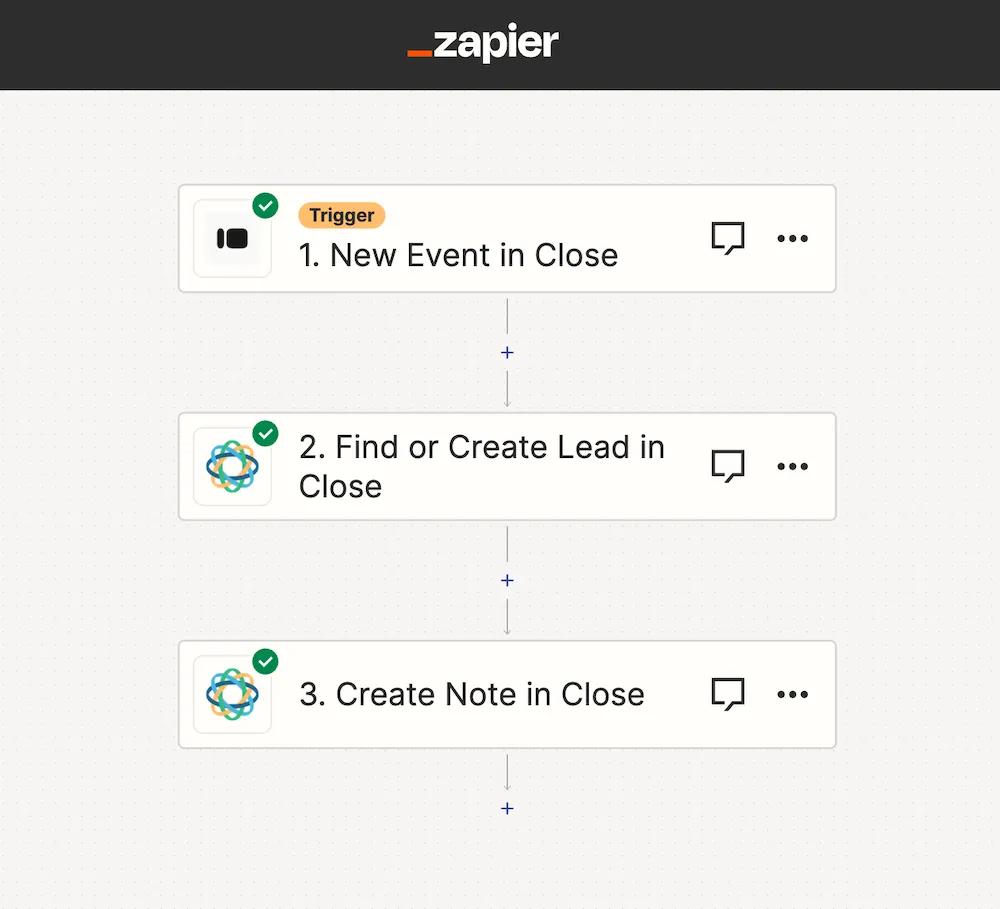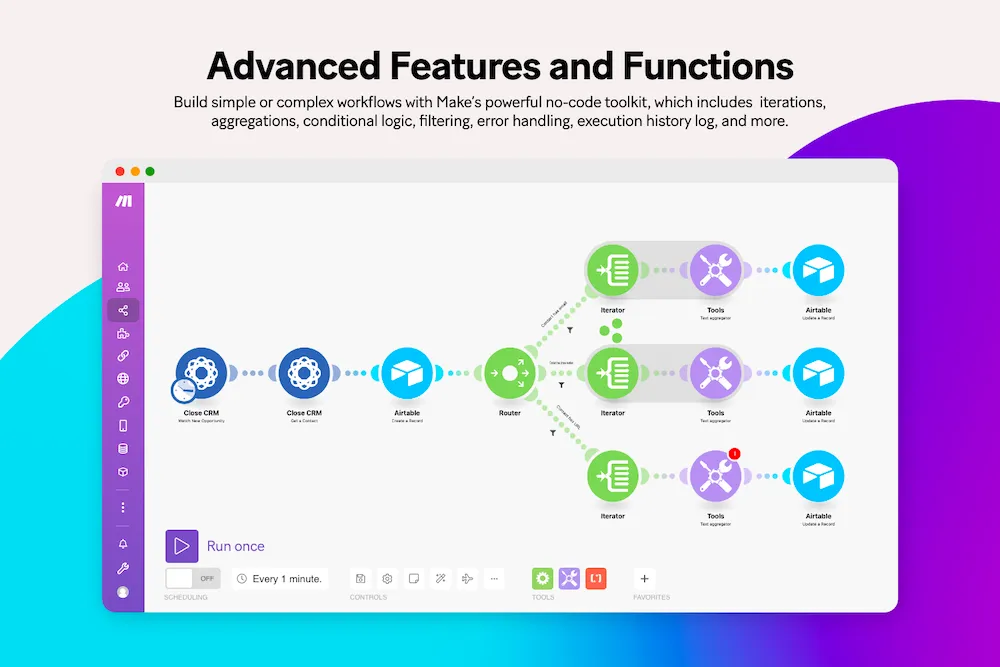
If you’re the strategic mind steering the sales team's success, your task is to equip your squad with the best tools so they crush quotas. But… the sales tools market is packed! And it’s tedious to test every single one.
Instead of spending weeks trying to put together the perfect tech stack, we've done the hard work for you. Check out our roundup of the top sales tools in six categories, including CRM, sales automation, sales prospecting, and more. Excited to see what's in store? We know you are!
Choosing the Best Sales Tools: Okay, Which Ones Do I REALLY Need?
Sales tools are like the equipment in your kitchen—each tool you choose should be integrally linked to helping your team create delightful customer experiences.
And since no two teams are alike, your choice of tools and how you combine them is unique to you.
Inbound teams might put a heavier focus on sales tools that integrate well with their marketing stack, while outbound sales teams would likely invest in sales prospecting software and outreach tools that boost productivity.
Let’s face it: a lot of tools on the market are like that shiny new kitchen gadget you see advertised and must immediately buy. Like a heated butter knife. Or a corn peeler.
Other tools try to do a bit of everything but aren’t really good at any of them. Like a toaster-oven-coffee-maker monstrosity. (This shit really exists, and we’re still wondering why.)
We’re not advocating either of these. Instead, we’re rooting for the collection of tools that fit your sales process and team, giving you actionable help that you really need (not just fun features you’ll probably never use).
For a good start, take a look at the three fundamental types of sales tools your business needs:
- Customer Relationship Management (CRM): Sales life without CRM is like building a house without a blueprint. Your CRM centralizes all your sales information, gives visibility into your pipeline, and improves communication with prospects and partners. Most CRMs are also communication tools, meaning your sales team can call, email, or text their leads right from one place.
- Prospecting and Lead Generation Tools: Think of these tools like a duo that helps your business hit aggressive goals. Lead gen tools ensure your pipeline stays full, and prospecting tools help your growth game stay strong. They minimize operational chaos and guide potential clients into becoming happy customers.
- Analytics Tools: Sales analytics tools give you fast access to customer data and the ability to create dashboards in minutes. Whether you're doing a quarterly check-in with a sales team member or seeking approval for a larger budget from management, the insights from analytics tools can enhance the persuasiveness of your story. Furthermore, harnessing ETL tools is crucial for contemporary data pipelines, facilitating seamless extraction, transformation, and loading of data from various sources into a centralized repository, thereby amplifying analytics and decision-making prowess.
If you don’t have time to read the whole article now, look at this summary.
Customer Relationship Management (CRM) Tools: The One Source of Truth for Your Customer Interactions
A CRM is your primary source of truth for all sales-related things. It is essential for managing prospect communication, setting up email automation, making calls, and keeping track of important notes.
Modern CRMs give you numerous features to assist you in staying organized, managing your sales pipeline effectively, and surpassing your sales goals. It is one of the most crucial tools in the sales industry because scaling is nearly impossible without it. Therefore, even if you're a small business with a limited budget, using a spreadsheet CRM is better than having no CRM at all.
Top CRM Tools for Small Businesses to Keep on Your Radar
Below are three recommendations for you:
Close CRM: For Growing Small Business and Startup Sales Teams
 |
G2 Review: 4.7 out of 5
Price: Startup — $49, Professional — $299, Enterprise — $699 (per month, billed annually)
If you’re looking for the ultimate sales tool to turn more leads into revenue, Close is your best option. (Okay, we may be a bit biased!)
Close is a communication-focused CRM—it’s a fast, simple platform that gives you all the tools you need (and none of the fluff you don’t). The tool lets you manage your sales pipeline, make faster calls with a Power Dialer, create custom Workflows, and even use AI to transcribe and summarize customer interactions.
Thanks to Custom Activities, Custom Fields, and Custom Objects, you can truly make this CRM your own. Plus, Close integrates with all your favorite tools, including Zoom, Gmail, ChatGPT, Hubspot, and more.
Monday Sales CRM: For Teams that Like Visual Tools
 |
G2 Review: 4.6 out of 5
Price: (3 seats) Basic — $12, Standard — $17, Pro — $28, Enterprise — Contact us form (per month, billed annually)
Let’s get one thing clear—Monday is not inherently a CRM. Their CRM is an extension of the project management capabilities of the tool. The CRM part is user-friendly and offers a visually intuitive interface, which may clarify your sales processes.
Its key functionalities come down to pipeline management, contact and deal tracking, email integration, and automation tools. Also, the tool has an AI component in Beta. It can help you turn ideas or meetings into actionable tasks or create content for your sales emails.
Bigin by Zoho CRM: For Your First Step Up From a Spreadsheet
 |
G2 Review: 4.5 out of 5
Pricing: (one seat), Free Edition — $0, Express — $7, Premier Edition — $12,
Bigin, a product by Zoho CRM, is designed mostly for smaller businesses and sales teams that want a straightforward CRM. As the name suggests, it’s very “beginner-friendly,” meaning that it’s more of an alternative to a spreadsheet CRM than to more advanced tools.
Bigin helps qualify leads, manage sales deals and sales operations, along with dealing with support tickets and customer onboarding. It’s a cost-effective CRM, offering a price of $7/user/month (billed annually).
Sales Automation Tools: Get More Done, Faster
Many sales professionals waste a lot of time on data entry tasks after taking sales calls, video conferencing, or communicating via email. This can be a time sucker—and it can lead to mistakes. Automating those tasks is one of the best ways to speed up your sales process and make sales reps happier.
Let's take a look at sales automation tools that will help your team spend more time selling—and less time typing.
Top Automation Tools You Should Look Into
Well, if you could cut time spent on tedious tasks by three hours a week, it means 156 hours saved annually. No-brainer, right? Let’s look at three top tools.
Zapier: Sales and Business Automation on Steroids
 |
G2 Review: 4.5 out of 5
Pricing: Free, Starter — $19.99, Professional — $49, Team — $69 (per month, billed annually)
Zapier is the most popular powerhouse for anything related to automation. It connects with over 3,000 apps, including Close CRM. What we love about Zapier is that it’s intuitive, even for non-technical sales leaders. Struggling with setting up a zap? We bet there are a couple of good tutorials online that will help.
You can use Zapier to automate lead assignments to ensure your team gets leads based on specific factors. Or you can use it to add contact information to your CRM from the lead form that’s implemented on your website. There are hundreds of ways, really, and if you want some inspiration, our friends at Zapier have a nice sales automation guide.
HubSpot: All-in-One Sales + Marketing Automation Tool
 |
G2 Review: 4.4 out of 5
Price: Free, Professional — $441, Enterprise — $1,470 (per month, billed annually)
HubSpot is an all-in-one, offering CRM, marketing automation, and sales engagement under one roof. You can set up automation there to cut low-impact tasks and free up your team’s time to do more meetings and outreach.
The tool has a two-way integration with Close to pass data back and forth automatically without Zaps or manual management. For example, sync contacts or leads between tools to bring new leads from HubSpot’s marketing tools into Close.
Make: A More Affordable Zapier Alternative
 |
G2 Review: 4.7 out of 5
Price: Free, Core — $9, Pro — $16, Teams — $29 (per month, billed annually)
Make (formerly Integromat) is a budget-friendly alternative to Zapier, offering advanced automation capabilities without breaking the bank. As a sales leader, you can create workflows, automate data syncing, use webhooks, and enhance lead management (psst, it natively integrates with Close, too!).
You can automate the process of updating CRM records based on prospect interactions. For instance, automatically create tasks for sales representatives when leads engage with specific content. If you’re looking for inspiration on automating your sales game, Make has a very cool article on that.
Sales Prospecting Tools: From Lead Generation to Deeper Sales Intelligence
The whole foundation of a sales funnel is based on sales prospecting to find new and qualified potential buyers. Gathering information on your prospects and improving this process with prospecting tools can make your job easier and quicker.
When your sales reps focus on more promising leads, the higher the chances to convert these leads into happy customers. Thus, it’s key for businesses to keep focused on decisive leads with good budgets.
Top Sales Prospecting Tools to Check Out
Now, off we go to top sales prospecting tools to improve your outreach strategy.
LinkedIn Sales Navigator: LinkedIn Prospecting Made Easy
 |
G2 Review: 4.3 out of 5
Price: Hidden Pricing
Does your sales squad use LinkedIn for prospecting? Great! Then using LinkedIn Sales Navigator is a a must-have platform to track lead activities on the social media platform. You can save lead lists based on your chosen criterion and get customizable notifications about your prospects.
Along with advanced search filters comes an option to keep extending the network, sending InMail, and creating custom lead lists to target prospects in the right stage of your sales cycle.
Reform: Forms With a Kick!
 |
G2 Review: N/A
Price: Basic — $15, Pro — $35 (per month, billed monthly/annually)
Reform offers a form builder for creating shareable, embeddable forms that integrate easily with your other tools. It's great for sales prospecting, allowing you to capture leads and gather inquiries or event registrations.
With generous plans, including unlimited responses, multiple questions on one page, and Reform branding removal, it’s a valuable weapon in your sales arsenal. And lastly, it’s part of the Indie Stack, integrating with Close and other tools like SavvyCal, SignWell, and Fathom.
Apollo: A Swiss Army Knife for Account-Based Sales
 |
G2 Review: 4.8 out of 5
Price: (one user) Free, Basic — $49, Professional — $79, Organization — $119 (per month, billed annually)
Apollo.io is a tool for sales teams that want to expand their prospect database with direct numbers, focused LinkedIn contacts, and professional work emails. It’s especially useful for teams that do a lot of outbound, like cold emails.
It helps you enrich current data, generate new leads, and engage them. This tool has Zapier integration, making it even easier to move prospects into the pipeline. For example, you can use Apollo for lead gen activities to automatically transfer qualified leads to your CRM for further conversation and follow-ups.
Sales Analytics Tools: Turn Data into Revenue
Sales is a numbers game. At the same time, there are so many sales metrics that it can get confusing what your team should be focusing on. Number of daily calls, average deal size, number of conference leads, customer acquisition cost, sales cycle length. And so on and so forth.
So, which metrics you should really track?
We’re fans of minimalism because the less you track, the more focused you and your team are. Here are some of our favorite metrics to track as a small business or startup:
- Customer lifetime value (CLV): CLV measures the total revenue a business can expect from a customer throughout their entire relationship
- Customer acquisition cost (CAC): CAC represents the cost a company incurs to acquire a new customer
- Sales conversion rate: The sales conversion rate reflects the percentage of leads or prospects that convert into paying customers (can be measured as a sales funnel).
- Pipeline coverage: the ratio that compares the value of opportunities in a sales pipeline to the revenue target, providing insights into the adequacy of potential deals to meet or exceed sales goals
When you ask us about analytics, a solid CRM will give you built-in reports to monitor important KPIs (and, in many cases, you won’t need another tool to track your sales data). But there are also tools dedicated purely to data. Here, we’ll focus on these tailored solutions.
Top Analytics Tools You Might Consider
Check out these top three analytics tools that can assist you in two ways: presenting data to your team to keep them motivated and driven and demonstrating your competence to your boss.
Chartmogul: A Tool Every SaaS Biz Should Have
 |
G2 Review: 4.6 out of 5
Price: Free, Scale — starts at $100, Volume — +$2000 (per month)
Chartmogul is a SaaS analytics tool that will help you track and analyze key metrics related to your business. It connects various data sources and gives you a view of metrics like Monthly Recurring Revenue (MRR), Churn Rate, Customer Lifetime Value (CLV), and more.
This tool will be the most handy for you as a sales leader. Thanks to Chartmogul, you keep track of the sales performance and revenue metrics, which helps you identify growth opportunities and enhance overall sales strategies.
Geckoboard: Easy, Visual Dashboards for Your Team
 |
G2 Review: 4.3 out of 5
Price: (three seats), Essential — $39, Pro — $79, Scale — $559 (per month, billed annually)
Geckoboard is a real-time dashboard tool that allows connecting 90+ data sources (including ChartMogul, Close, Google Analytics, HubSpot, and more) and presenting it in a dashboard form. It’s pretty flexible, so you can cook up dashboards according to your individual needs.
Besides your analytics dashboard in your CRM, Geckboard adds another, as the metric tracking possibilities are endless. You can also set up a TV dashboard in your workspace to make data accessible to everyone and to keep your team motivated.
Or, as a sales leader, you can create a sales competition dashboard where you’ll encourage your team members from various regions to have a friendly competition.
As we already mentioned, Geckoboard plus Close is a great combination that lets you visualize live activity and performance metrics from your Close account, like value won, leads contacted, emails sent, and average call duration.
Rows: A Cooler Alternative to Google Sheets
 |
G2 Review: 4.9 out of 5
Price: (Unlimited members), Free, Plus — $69, Pro — $189, Enterprise — contact us (per month, billed annually)
We know that sometimes Google Sheets are just… overwhelming. Enter Rows: spreadsheets where your team can work faster, make more, and integrate it smoothly with other tools.
Thanks to integrations with apps like Facebook/Google Ads, Stripe, and Twitter, your team can automate lead generation, enrich and qualify leads, and update your CRM from within the spreadsheet. What’s cool about Rows is that it also allows you to build forms and track social mentions of your competitors.
Sales Management and Enablement Tools: The Software You Need to Manage and Enable Your Team
Again, the best sales management software (and often the only one you need) is your CRM. This is where you monitor rep activity, analyze your pipeline, and even set up a clear strategy.
But aside from the CRM, using sales management and enablement software gives your team balance. You coach and train your team to become better salespeople, and these tools organize and centralize the resources your team needs to succeed.
Top Sales Management Tools that Improve Balance Within Your Team
Now, off we go to sales management tools that will make content sharing within your team (and with prospects) a breeze.
Showpad: Space for Sales Leaders to Train, Coach Reps, and Centralize Content
 |
G2 Review: Showpad Content 4.6 out of 5, Showpad Coach 4.4 out of 5
Price: Hidden Pricing
Showpad is an Enablement Operating System that helps sales and marketing teams get alignment around high-impact buyer interactions.
It’s a great tool for sales leaders as the platform lets you train and coach your team. They can deliver bite-sized learning experiences based on different parts of their sales process and evaluate their team with quizzes.
It has AI-powered recommendations to surface the right content from your entire content library so each rep knows what to send and the effectiveness of different pieces in closing deals.
Paperflite: Content Enablement with Clear UI
 |
G2 Review: 4.7 out of 5
Pricing: (One user), Sales Content Management starts at $50, Interactive Content Experiences starts at $500, Design Studio for Customized Content Experiences — pricing upon request
Paperflite is a content enablement platform that helps sales teams organize, share, and track their sales collateral and marketing content. It makes it easier for sales leads to access and deliver relevant materials, track engagement, and ultimately enhance their sales communication.
Imagine you’re preparing a sales presentation for a prospect. Paperflite will help you access a centralized hub of up-to-date marketing collateral, share tailored content with clients, and receive real-time insights on how clients interact with the materials.
Seismic: Centralized Sales Content Hub
 |
G2 Review: 4.7 out of 5
Pricing: Hidden Pricing
Seismic streamlines your sales process by centralizing all your sales resources in one place. As a sales lead, you can easily access the latest sales collateral, product sheets, case studies, and presentation templates to deliver compelling pitches and engage prospects more effectively.
Sales Productivity Tools: Getting the Most From Your Time
Sales productivity tools are the last category we analyzed. Here, you’ll find tools that save you time and frustration and help you enjoy your work more.
There are many tiny tasks in everyone’s job that we just don’t like. Taking notes, signing contracts, or finding a free slot for five people can be annoying. These tools help your team stay focused on what’s most important—selling.
Top Productivity Tools You Should Look Into
So, take a look at our favorite three tools that can save you tons of frustration going forward.
SavvyCal: A More Intuitive Calendar Tool Built for Sales
 |
G2 Review: 4.7 out of 5
Pricing: (One user), Free, Basic — $12, Premium — $20 (per month)
For sales leaders, SavvyCal is a must-have tool for scheduling and managing prospect meetings.
You can embed SavvyCal directly into your website and let prospects schedule meetings with your team. The booking software can also automate round-robin lead distribution and shows the collective availability of your team members to recipients.
You can set your preferred meeting times and create time blocks to control your availability. SavvyCal also integrates with Close and can update your Close contacts when a prospect books a meeting with your team.
Fathom: Stay Present During Your Meetings
 |
G2 Review: 5 out of 5 (wow!)
Pricing: Free (contact for more information on pricing/needs)
Fathom, the AI Meeting Assistant, boosts your sales game. We use it at Close to enhance our listening skills. Fathom records, transcribes, and summarizes meetings, letting you focus on relationships and key pain points.
It also analyzes top performers' conversation flows to coach your team. Plus, it seamlessly integrates with Close, pushing recordings to your account, syncing them with the right contacts, and adding notes and summaries right into your lead profiles.
SignWell: Simple and Affordable E-Signature Tool
 |
G2 Review: 4.8 out of 5
Pricing: (One sender), Free, Personal — $8, Business — $24, Enterprise — Contact us (per month, billed annually)
Every salesperson deals with paperwork. (And it’s usually the bane of their existence.) To stay on top of sealing deals, we choose SignWell. We love it because it’s simple and affordable.
SignWell plays a crucial role in sales automation, seamlessly integrating with your CRM to streamline processes. You can automatically trigger the delivery of a contract from a status update in Close, or update lead status in Close based on activity in SignWell. Plus, all your contracts are automatically pre-filled with lead data from Close. Cool, right?
Follow These 8 Steps to Choose the Right Sales Tools for Your Team
We know, we know… Choosing the right tools can be tricky. You want to balance team performance, tool budget, and usability. To assist you, we've put together a brief checklist to ensure you've covered all the important criteria.
Take a look at the key steps to choosing the right tools for you:
- Assess your needs: Identify the specific challenges and gaps in your sales process that tools can address.
- Define goals: Clearly outline your objectives and what success looks like with implementing new tools.
- Consider integrations: Choose tools that integrate with your existing stack (the more native integrations, the better).
- Find a user-friendly interface: Prioritize tools with an intuitive interface to ensure easy adoption and minimal training time.
- Determine the price-to-quality ratio: Prepare a rough budget for each tool and check if it’s delivering the promised value.
- Think about scalability: Opt for tools that can grow with your business to address future needs.
- Use the trial period: Take advantage of trial periods to assess how well tools align with your team's requirements.
- Seek feedback: Let your sales team be the decision-makers, considering their insights and preferences.
Choosing tools that are fundamental for your team is a strategic decision. If you’re at the point of considering what CRM you should go with, check whether Close is the best second brain for your sales team.










